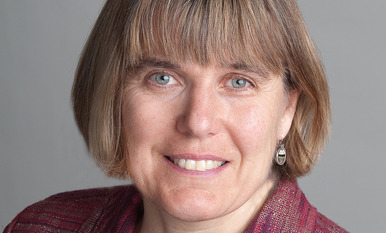Healing the World with Hope: A Q&A with Dr. Barbara Rossing
May 13, 2016 • By Barbara Rossing
For many, the New Testament Book of Revelation is associated with dark, apocalyptic imagery. But Barbara Rossing, Professor of New Testament at Lutheran School of Theology at Chicago, is working to reclaim an image that appears twice in Revelation: the tree of life for the healing of the world. Using the image of the tree of life—along with the metaphor of abundant life found in the Book of John—Rossing is working to create a positive, constructive vision of the future that we can move toward with hope.
Read Barbara Rossing's blog post about the new tree of life and the biblical tree of life here.
What was the seed or the spark for the research you’re pursuing for the Enhancing Life Project? Are these new questions, or an extension of past research, or both?
For a long time, I’ve been researching eschatology: biblical authors’ visions of the future. I’ve looked at how Jesus and the early Christians who followed him were critiquing the Roman eschatology of empire without end and saying, no, the empire is coming to an end. I’ve drawn parallels to some of the problematic visions of the future in our day, especially escapist visions such as the Rapture and the Left Behind novels. But now I’m flipping it around and looking at these questions positively. What is a constructive vision of the future to which we can say yes? What are some of the New Testament images that are positively constructed? What might they look like for us and how might they help us imagine our future on earth?
What are the New Testament images that you’ve chosen to help guide this work, and why did you choose them?
In the gospel of John, Jesus says, “I came that they might have life, and have it abundantly.” A lot of people think abundant life means bigger houses, more cars. We’ve had a certain American vision of abundant life that can’t continue. And that’s probably good. Jesus says life doesn’t consist in the abundance of possessions. So abundance is good, but we have to define it differently. Social science researchers have found that what makes people happy isn’t more and more money or more possessions, it’s relationships or a sense of purpose. So theologically, what is true abundance for people? Is it sustainability? Community?
The tree of life is one of the central images in the book of Revelation. It appears at the beginning as a promise of paradise to the church in Ephesus. And then it comes at the end of Revelation as a very earth-centered vision: a city, a kind of urban paradise. In the middle of the city is the river of the water of life, and on either side of the river is the tree of life. It’s not very logical (how can the tree be on both sides of the river?) but it’s a magnificent image of renewal, of beauty, of fragrance. It bears fruit twelve months of the year. And it’s got these leaves that are for healing the nations. So I say the book of Revelation doesn’t end with war and Armageddon. God’s will isn’t to destroy the nations—it’s to heal.
What’s the most surprising or interesting challenge you’ve encountered so far in your Enhancing Life Project research?
Part of my project focuses on visual culture. I’m exploring eschatological images, and that’s a challenge because it’s a new field for me; I don’t have an art background. It’s important, though, because Revelation is extremely visual: John, the author, keeps saying, “I saw this, and I saw that.” Seeing is at the heart of the book. And people have found really amazing ways to draw on the images of the tree of life. There is a quote in John where Jesus says, “I am the vine and you are the branches,” and people have seen themselves as the branches of the tree or living in the tree. And Darwin also used the tree of life as a metaphor for our phylogenetic lineage. So what is it about this tree that helps us see connections to other people, communities, and organisms?
How do public debates shape your work? What are you hoping to offer those debates?
I want to focus on concrete images of hope. I do a lot of work with climate change, and early on, people thought that the best way to raise awareness and change behavior around climate change was to basically engage in fear-mongering. But fear doesn’t get anyone to change—people just despair. I think we are definitely going to survive climate change, but we may need to change the way we think about it. In disability studies, it’s often pointed out that healing is not the same thing as a cure. Climate change is like a chronic illness that we have to stabilize and then live with. But there’s hope and we can continue to find abundant life nonetheless.
You don’t spend all of your time doing research and teaching! What’s your favorite place to travel, or the next place you’d like to go?
I’d like to go to Italy to see the column of Trajan, because I think Roman imperial monuments show very clearly the eschatological claims of Rome. That’s for research, of course. When I travel otherwise, I just love doing a lot of hiking and back-country skiing.